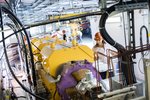Joining forces for cancer research: TRON and GSI/FAIR study combination of heavy ion therapy and mRNA vaccine
18.04.2024 |
It could be a new, promising combination of two therapeutic approaches and a key to better combating advanced-stage cancer. Two strong partners have joined forces to explore this possibility: The biopharmaceutical and translational research institute TRON in Mainz with its highly specialized oncology research and the GSI Helmholtzzentrum für Schwerionenforschung in Darmstadt with its worldwide unique accelerator facilities and the cancer therapy with ion beams developed here. Researchers from both institutions have now published the results of their joint work in “International Journal of Radiation Oncology, Biology, Physics”.
As part of the FAIR Phase 0 experimental period on the GSI and FAIR campus, TRON, in collaboration with the GSI Biophysics Department headed by Professor Marco Durante, used the accelerator facilities to combine particle therapy and immunotherapy as the mRNA-based cancer vaccine. The experiment has entered uncharted territory with this combination. The aim of the current proof-of-concept experiment at GSI/FAIR was to directly compare the efficacy of carbon ion radiotherapy (CIRT) and conventional X-ray radiotherapy, each combined with an mRNA-based vaccine specific for a mouse tumor model.
It is already known from preclinical studies by TRON that the mRNA-based vaccines achieve effective results in combination with conventional X-ray radiotherapy. The question now was which effects are caused by carbon ion radiotherapy in combination with immunotherapy and which potential carbon ion radiotherapy has for tumor growth inhibition. The two GSI/FAIR researchers Professor Claudia Fournier and Dr. Alexander Helm explain: “The combination of this powerful systemic drug with densely ionizing, local heavy ion radiation could be a powerful tool in the fight against cancer.”
TRON's and GSI/FAIR’s research is still a glance into the future. “The findings have given a first orientation that heavy ion radiotherapy might benefit from combined immunotherapy, using mRNA cancer vaccines, and could be instructive for the translation of radio immunotherapy combinations using heavy ions into the clinic,” explain TRON scientists Dr. Fulvia Vascotto and Dr. Nadja Salomon. The study examined a colorectal adenocarcinoma, a type of tumor that occurs in the intestine and is one with the highest incidence in Western countries.
As the study shows, mRNA-based vaccines significantly potentiate tumor growth inhibition induced by radiotherapy. Cell growth is significantly reduced for carbon ion compared to X-ray radiotherapy. Although both carbon ion therapy and X-ray therapy alone inhibit tumor growth, they only marginally prime specific immune responses against the tumor itself.
It is known that<s> </s>the immune system plays an important role in preventing and curing cancer<s>.</s> Usually, the immune system recognizes degenerated cells and can “sort them out". At the same time, it is equipped with highly complex control mechanisms to avoid overreactions. This is exactly what cancer cells can sometimes use to their advantage and to down-regulate immune surveillance. They disappear from the radar, so to speak, they camouflage so skillfully that the endogenous defenses do not recognize the enemy or are too weak to attack it. Individualized mRNA vaccine educates and reactivates the immune system in its fight against cancer and support in situ anti-tumor immune responses.
TRON and GSI/FAIR showed now evidence that carbon ion therapy is superior to X-ray therapy regarding cell death induction and tumor immune-modulation in murine tumor cell lines. This increases immunogenicity, i.e. the ability of the immune system to recognize the tumor.
In conclusion, the study has provided for the first time a comparative result for carbon ion and X-ray therapy in combination with mRNA vaccines: the vaccines show similar overall therapeutic efficacy in combination with both ion beams and X-rays, but the physical radiation dose is lower for carbon ions than X-rays. Even if the path to a possible clinical application is still long and many steps still need to be taken: The authors conclude that the combination of carbon ion radiotherapy and mRNA-based vaccine is a promising strategy for treatment of radioresistant tumors. (BP)
Further information
The mRNA based vaccine
The approach pursued at TRON leads to a stimulation of the immune system via systemic vaccination with messenger RNA (mRNA). With the vaccination - the fragile mRNA is packed in a protective lipid envelope - the tumor-diseased organism receives valuable information. The vaccine up-taken by antigen presenting cells in the spleen activates these cells while they produce specific portion of the tumor associated antigens. On the consequence the immune system starts an education and reactivation program which allows T cells to attack the mutated cancer cells. The cancer vaccine is based on similar technologies as mRNA-based vaccines used against Covid-19, while injected intramuscularly.
The ion-beam therapy
The tumor therapy with heavy ions developed at GSI provides high precision in the administration of the dose: the ions develop their damaging effect at the end of their trajectory at a certain depth, which depends on the ion velocity. The administration of the heavy ions is sophisticatedly controlled with the release of a low dose in the healthy tissue while it reaches a sharped increase in the tumor mass. This causes irreparable damage to the genetic material of the cancer cells without causing additional stress to the healthy tissue.

















